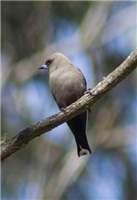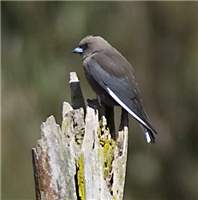Family
Artamidae
Genus
Artamus
Species
cynopterus
Threats/Control Methods - Regional
The key woodland habitat area for this species in the ACT region is currently considered an Endangered Ecological Community. Land clearing for urban development and agriculture is the greatest contributor to this problem. The invasion into these areas by introduced weeds, grazing and predation by feral and uncontrolled domestic animals are also key threats.
Threats/Control Methods - Local
Habitat simplification by 'tidying-up' forest areas within and nearby the suburbs will limit the areas that are favourable to this species, as will free roaming domestic Cats (Felis catus).
Local/Urban Actions
Dog owners should always keep their pets on a leash and cat owners can prevent their pets preying on the species by creating a stimulating indoor environment and by installing a cat run or enclosure. Collecting firewood from nature reserves or national parks should not be undertaken, as this will impact on the important foraging and nesting resources.
Common Names
Dusky Woodswallow, Skimmer, Summer Bird, Wood Martin
Distinguishing Features
This medium sized bird has dark eyes and a thick, dark pointed bill. The head and body is a dark brown-grey colour, while the wing feathers are dark above and light grey underneath. The wings are edged with a unique white streak and the tip of the tail is white. Young birds are lighter, with brown and cream streaks throughout their plumage.
Survey Techniques
Call and visual identification.
Species Call
a quick, vibrant 'tseit-tzeit' or a soft, sweet song, also some mimicry
Similar Species
Other Woodswallows are similar in size and shape, however with unique markings and colourings.
Distribution
Locally, this species is found on the more open, grassy woodland areas around Lake Burley Griffin such as on BMP and Acton Peninsula.
Country of Origin
Australia
Conservation (Pet/Pest) Status - Regional
The number of this species has fluctuated over the past 25 years in the Canberra area and is considered a 'Bird to Watch Out For' by Greening Australia of the ACT and SE NSW region.
Conservation (Pet/Pest) Status - National
Secure, not listed under the EPBC Act 1999. They are classified as declining across the wheat-sheep belt of NSW.
LSCCES Population
11 sightings were made at the National Museum of Australia.
Associated vegetation community
The Dusky Woodswallow is a predominately a woodland bird, however it is also found in dry open forests or in larger vegetation patches around farms or along roads.
Limiting Resources
This species is limited to areas where there is a complex vegetation structure that includes mature trees, thick shrubs and good ground cover and fallen logs. It also relies on areas away from predation by feral or domestic animals.
Breeding
This species breeds in Canberra's surrounding woodland areas in the summer, with activities at the nest beginning from mid-October to late November. The nest is an untidy shallow cup of twigs, constructed on a tree fork, in a tree cavity or on a stump, from 1-20 metres off the ground. The nest's interior is neatly lined and holds 3-4 cream and brown speckled eggs. Eggs hatch after about 16 days incubation and are fed by both parents and sometimes the young birds from previous years. Dependant young are visible during December and January, having left the nest after 20 days.
Behaviour
This bird if very social and is likely to be spotted perching on powerlines or fences in pairs, small groups or large breeding colonies. It travels in large flocks, gliding and soaring with some quick wingbeats. Upon landing, the Dusky Woodswallow wags its tail. It is seen throughout the Canberra region in highest numbers during late summer and autumn, before migrating north for the winter.
Functional Group
Food Species
The Dusky Woodswallow prefers to eat a wide range of insects, however it will also drink nectar.
Predators
Domestic or feral Dogs (Canis familiaris) and Cats (Felis catus) may predate this species.
Interesting Fact
Dusky Woodswallows nest close together, forming a 'neighbourhood watch' and joining to defend one others' nests.
References - (reader suitability of references, P=Primary teachers, S=Secondary students, T=Tertiary students and researchers)
Books:Freudenberger, D. 2001. Bush for the birds: Biodiversity enhancement guidelines for the Saltshaker Project, Boorowa, NSW. Consultancy report to Greening Australia ACT and SE NSW Inc. CSIRO Sustainable Ecosystems. Canberra. S, T
Morcombe, M. 2000. Field Guide to Australian Birds. Steve Parish Publishing. Archerfield. Australia P, S, T
Pizzey, G. 2000. The Graham Pizzey & Frank Knight Field Guide to the Birds of Australia. Angus & Robertson, Sydney. P, S, T
Schodde, R. and Tideman, S. (eds) 1990. Reader's Digest Complete Book of Australian Birds (2nd Edition). Reader's Digest Services Pty Ltd. Sydney. P, S, T
Taws, N. et al. 2001. Bringing Birds Back: A Glovebox Guide for Bird Identification and Habitat Restoration in ACT and SE NSW. Greening Australia ACT and SE NSW Inc. P, S, T
Veerman, P. 2003. Canberra Birds: A report on the first 21 years of the garden bird survey. Philip Veerman and Canberra Ornithologists Group. Canberra. S, T
Internet: Birds in Backyards. 2006. [online]. Available at:http://www.birdsinbackyards.net P, S, T
Canberra Ornithological Group (COG). 2004. Birds of Canberra Gardens. COG and the ACT Department of Urban Services. [online]. Available at:http://garden.canberrabirds.org.au/ P, S, T
Online Publications:ACT Government. 2004. Woodlands for Wildlife: ACT Lowland Woodland Conservation Strategy. Action Plan No. 27. Environment ACT, Canberra. [online]. Available at: http://www.environment.act.gov.au/nativeplantsandanimals/threatecspec/woodlandsstrategy S, T
Nix, H. and Cunningham, R. 2006. Birds of the Lower Sullivans Creek Catchment, Canberra ACT. Prepared for the Life in the Suburbs project using data from the Lower Sullivans Creek Catchment Ecological Survey (LSCCES). Australian National University. Canberra. [online]. Available at: http://www.lifeinthesuburbs.com.au/category.php?id=65 S, T
Researcher: Naomi Hogan


 Top
Top Top
Top